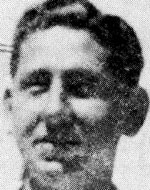Lifshitz, Zalman
Son of Jacob and Devorah. He was born on July 14, 1920, in the city of Rezice, Latvia. In 1925 the family moved to Riga, where Zalman studied at a Jewish school. The older members of the family joined the pioneering youth movement of Hashomer Hatzair and the family apartment became a mini-movement club where various activities of youth groups took place, and as a child, he absorbed the great spirit and as a child became part of the movement. 13 years old. He worked in the profession of mechanics and succeeded in it, and when his older brothers went to the training he became the provider of his mother and younger brothers. He was kind and courageous, proud of his Jewishness. After the outbreak of the Second World War, when Latvia was attacked by the Germans, a group of refugees set off on their journeys – and Zalman among them. When they reached the Latvian-Estonian border, the package was separated and Zalman and two others volunteered for the Latvian Division, which was organized on the spot. After suffering from bombardments and starvation, his unit was dispersed and by luck, he found out the whereabouts of his family. In October 1941, he was drafted into the army and participated in fierce battles for the defense of Moscow. He was wounded in the leg and due to his disability was released from military service, but after several months he was drafted again. He was finally released completely and returned to his mother-village and his work as a tractor and agricultural machinery. His proud stance as a Jew and his excellence in work brought him respect from both sides. In the summer of 1945, the family moved to Riga, where his eldest son was born. Was one of the escapees in Riga and organized an illegal immigration to Palestine. After a while, the family moved from Poland to Germany, traveled in refugee camps and settled in a camp near Kassel, where they remained until their immigration to Israel. Zalman was active in a branch of the Nocham movement and was a sports teacher, and his second son was born there, and when he was in Germany he thought of joining Ein-Gev and was already working there for the purchase of machines and tools, The war and the evacuation of the children from the farm did not come to Ein Gev until some time later, when he entered the kibbutz and all the members felt that the man was starting to live his life again.but he fell while he was seving in the army 1950) and was laid to rest in the cemetery at Kibbutz Ein Gev, and in the 30 days of his fall the kibbutz published a booklet in his memory and in Iyar 5711 thekibutz published a pamphlet entitled “The four who left, dedicated to him and another three-kibbutz member who were gone.
